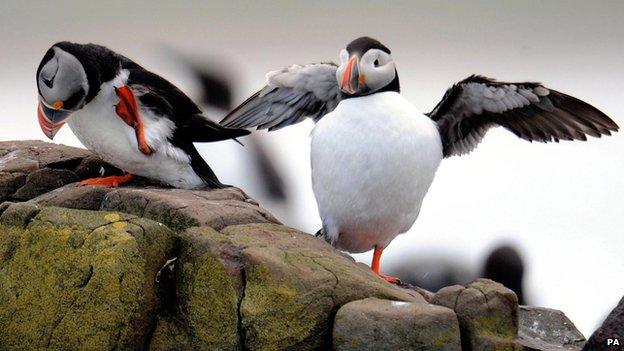Numbers of breeding puffins on Fair Isle halved
- Published
Researchers believe young puffins have not been returning to Fair Isle to breed
A long-term study of a large puffin colony on Shetland suggests that numbers breeding there have halved from about 20,000 to 10,000 individuals.
The study, published by the scientific journal PLOS ONE, covers a period of almost 30 years starting in 1986.
Researchers believe the most likely cause of the decline in the colony on the Fair Isle was young birds failing to return.
This could be because of a lack of fish for the puffins to feed on, they said.
Dr Will Miles, of the Fair Isle Bird Observatory, said: "We don't know exactly why they would fail to return to Fair Isle and settle to breed but it may be due to declining local fish stocks and poor feeding conditions for seabirds in Shetland waters.
"It is very difficult to find out exactly what happens to immature puffins after they have fledged because of the vast sea areas and the problems of tracing them within other colonies."
The study suggests that since the 1980s the quantities of fish brought ashore by adult puffins for their chicks declined substantially.

The RSPB described puffins as one of the public's most popular birds
Dr Miles also looked at the possible impact of great skuas on the puffin colony.
The number of these predatory seabirds, also known as bonxies, has increased by about 300% on Fair Isle in the same period, to more than 400 breeding pairs.
Dr Miles said he was surprised to find that, despite this increase, adult puffin survival on the island has remained high and stable over the 30 years.
He said: "It seems adult puffins on Fair Isle are pretty good at avoiding skuas and do not get heavily predated by them."
Dr Mark Bolton, of the RSPB, was an advisor to the Fair Isle puffin study.
He said: "The UK supports internationally important populations of puffins, which are among our best-loved seabirds.
"Whilst visitors to Fair Isle can still enjoy the spectacle of thousands of birds, the severe decline reported in this study is cause for considerable concern."